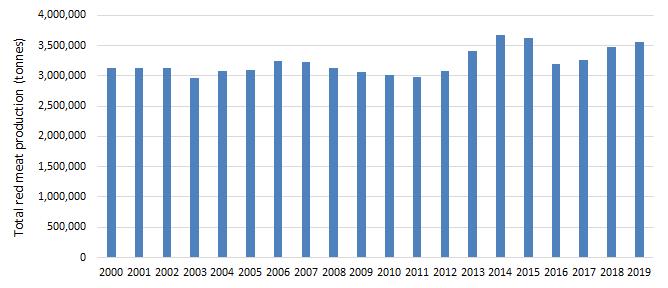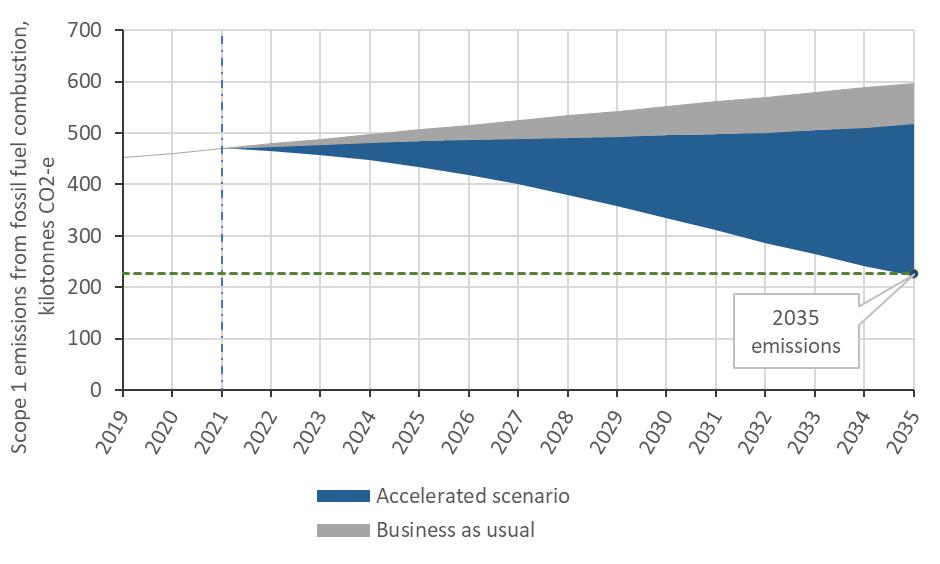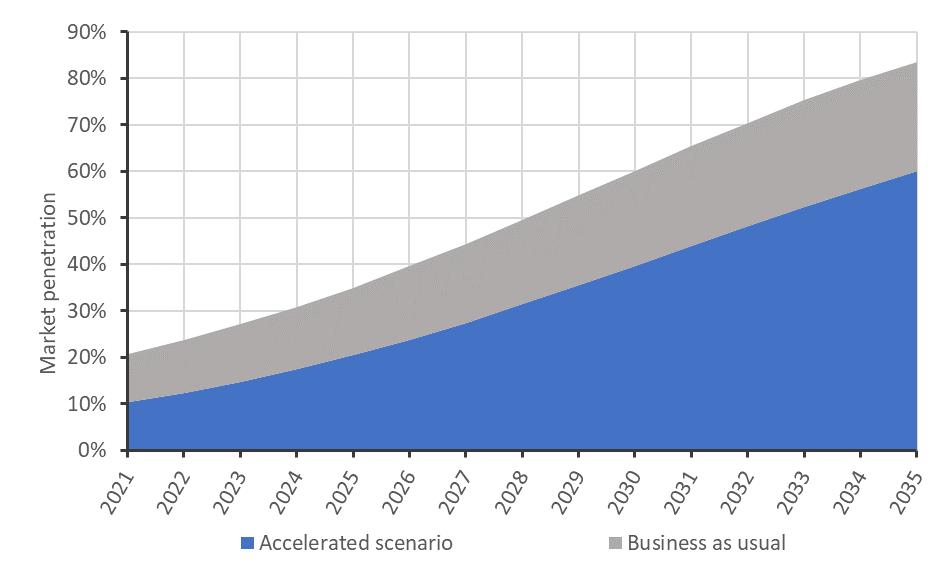
7 minute read
4.4.2 Meat Processing
4.4.2 Meat Processing
Market potential at a glance In 2019, the Australian meat processing sector consumed 7.48 PJ of energy for thermal processes <150 °C o This resulted in 452 kilotonnes of CO2,eq per annum of greenhouse gas emissions o The cost of fossil fuel consumption for this sector is approximately $55 million per annum o The demand for energy is expected to grow at approximately 2% per year in the near future Based on a logistic model, by 2035: o Under the BaU scenario, the emissions will increase by 66.5 kilotonnes of CO2,eq per annum relative to 2019 levels o Under the accelerated scenario, emissions will reduce by 292.5 kilotonnes of CO2,eq per annum relative to BaU o To achieve the 50% emissions target by 2035, the uptake rate of renewable technologies needs to be increased by a factor of 3.5 compared to the BaU scenario; o Under the ACL scenario, fossil fuel consumption costs will be reduced by $36 million per annum relative to the BaU scenario.
Advertisement
Australia’s red meat and livestock industry contributed significantly to Gross Domestic Product (GDP), i.e. 17.6 billion AUD in 2018-19 equivalent to 1.4% of Australia’s key industry GDP [237]. This industry employed 31,200 people in meat processing, which accounts for 17% of total full-time equivalent employment in the Agriculture, Forestry & Fishing sector [238]. Figure 80 below presents the amount of red meat production in Australia since 2000. Continuously growing from 2016, Australia’s red meat production totalled 3.56 million tonnes Hot Standard Carcase Weight (HSCW) in 2019 [239].
Steam is the main source of heat in the meat processing. A typical process requires approximately 2.1 GJ of heat per tonnes of HSCW on average. Medium pressure steam at temperatures around 180 °C –185 °C, generated by the central boilers, is used directly in rendering and blood processing, which demands most of heat (≈88%). The waste heat from exhausted steam in the rendering process is recovered and used to supply hot water (82 °C) and warm water (43 °C) for sterilization, slaughter, and evisceration processes. Almost 60-70% of energy needs for hot/warm water comes from the waste heat. Figure 25 provides the meat processing overview and summarizes the energy and temperature demand in each process.
Figure 80: Australia’s red meat production since 2000 [239].
The Australian Meat Processor Corporation (AMPC) and Meat & Livestock Australia (MLA) reviewed the energy use in 14 red meat processing facilities and reported a 27% reduction in energy usage for both process heat and refrigeration from 2008-09 to 2013-14 [240]. The energy efficiency improvement was mainly attributed to the use of biogas captured from wastewater treatment on site, which increased from zero in 2008-09 to 6.6% in 2013-14. The natural gas usage was reduced from 37% in 2008-29 to 30.2% in 2013-14, substituting by the biogas. Biogas is the by-product from wastewater treatment, though it consumes about 74 kg CO2-e per tonne of HSCW [240], it is not accounted in the scope of this calculation. However, the cost of biogas is assumed to be $2/GJ, half the cost of that distributed in the pipeline, considering the cost of facility and operation. The other major energy source for steam production is coal. This work neglected the minor energy sources (e.g. LPG, biomass) and assumed that only natural gas, coal, and biogas are the boiler fuels for process heat, accounting for 54.5%, 35.1% and 10.4% after adjustment, respectively. This composition of energy sources is based on the latest report published by AMPC and Meat & Livestock Australia in March 2021. On average, the annual replacement rate of natural gas is approximately 1.0%. It is estimated that the GHG emission is 481.0 kilotonnes of CO2eq and the energy consumption for heat generation is 7.48 PJ based on the production in 2019.
4.4.2.1 Meat Processing Technology Options Table 30 summarized the promising solutions to reduce energy consumption and/or applying renewable energy to deliver heat in meat processing. Overall, the technology opportunities are similar to that presented in Section 4.4.1 for dairy, apart from a variety of differences.
Maximum temperature needs are approximately 145 °C, which MVR/HP can achieve. Furthermore, solar thermal can readily achieve this steam need at higher efficiency than in the dairy application.
Freezer temperature refrigeration is needed in addition to cold room refrigeration. Therefore, the potential of combined heat and cooling with HP should be considered. However, with freezing needed, multi-stage HP is required which can reduce the value proposition.
Meat works produce a significant amount of biowaste, which can potentially be used to produce biogas from biodigestion [241]. Biogas production will minimize waste charges while delivering a fuel of value. It is unlikely that the biogas production will provide sufficient heat to meet all the load, but
it can reduce the use of fossil fuels. However, rather than relying on fossil fuels using HP/MVR or solar thermal technology to deliver 100% decarbonization should be considered.
Biogas burning and HP combined heating and cooling can be viewed as complementary technologies. HP can deliver the heating needs that biogas cannot, and vice versa. Furthermore, should gas grid biomethane injection prove viable in the future, this can be implemented through an expansion of HP or the application of solar thermal without stranding the biogas production facility.
Overall, combinations of technology are needed to be considered to deliver not only a commercially viable solution, but a technology strategy is needed for decarbonization over time.
Table 30: Technology options with the potential to electrify/decarbonate meat processing.
Processes require heat Heat demand
Option 1 Option 2
Option 3 Option 4 Option 5 Option 6 Option 7 Option 8 Example optimal option Biogas generation on site + biogas boiler, reduce heat loss, recover waste heat to preheat water PV + HP + storage (to meet the rest of demand if biogas is insufficient) Recover waste heat from rendering process, PV + HP + storage (to meet the rest of heat demand)
Rendering and blood processing Sterilization, slaughter & evisceration
Steam at 115-145°C, 1.6-2.1 GJ/t HSCW
Hot/warm water at 43-82°C, 0.2-0.3 GJ/t HSCW Produce biogas using wastewater on site + biogas boiler Maximize waste heat recovery from rendering and reduce the heat loss from steam reticulation system
Recover waste heat from boilers and chillers to preheat boiler feed Biomass boiler EB/HP/MVR + renewable grid electricity (via PPA’s) Solar PV + EB/HP/MVR + storage (thermal or battery) Solar thermal Solar thermal + thermal energy storage
4.4.2.2 Meat Sector Market Uptake Since the approach of generating biogas on site and substituting natural gas as boiler fuel is underway, it is considered as the BAU scenario and the average replacement rate of 1.0% per year (constant) is considered as the technology market penetration. The growth in energy demand, based on historical data, is estimated to be 2% per year. Biogas accounted for 10.4% of the total energy source for heat production in 2020 and it is used as the initial/current adoption level (Po) for both BAU and ACL scenario. The results are shown in Figure 81 and in Figure 82. The results show that to achieve a 50% reduction in emissions by 2035, the uptake rate of renewable process heat technologies needs to be increased from the current 1.1% per year (under the BaU scenario) to approximately 3.7% per year (a factor of 3.5 increase). The results also show that the annual emissions actually increase under the BaU scenario, because the growth in energy demand outpaces the uptake in renewable technologies. Under the BaU scenario, by 2035, the annual emission would increase to 578.3 kilotonnes of CO2eq per annum.
In 2035, the cost of fossil fuel consumption under the BaU scenario is estimated to be 66.5 million AUD per annum, while under the accelerated scenario, this reduces to 27.5 millon AUD per annum. Figure 83 shows the net change in annual fossil fuel cost for both the BaU and accelerated scenarios. As can be seen, under the BaU case, the cost of fossil fuel consumption increases, because the growth
rate in demand outweighs the energy reduction due to renewable energy uptake. However, under the accelerated scenario, the reduction in fossil fuel costs decreases near-exponentially, and by 2035 a reduction of 36 million AUD per annum relative to the BaU case is estimated from the model.

Figure 81: Projected scope 1 GHG emission reduction up to 2035 for meat processing under BAU and ACL scenarios.
Figure 82: The overall new technology market penetration in meat processing under BAU and ACL scenarios.


Figure 83: Net change in annual fossil fuel energy cost for the meat processing sector relative to 2019 levels





